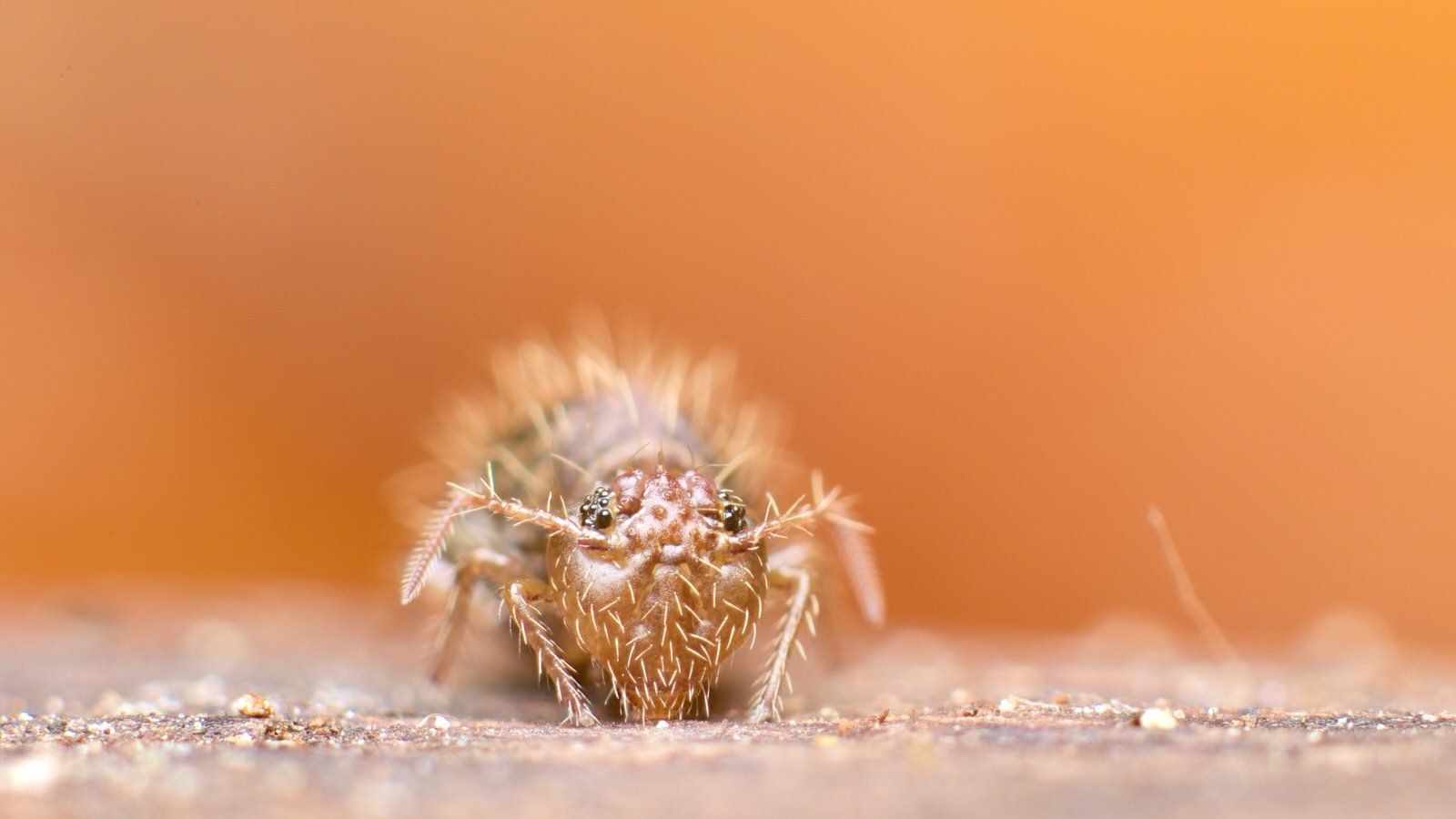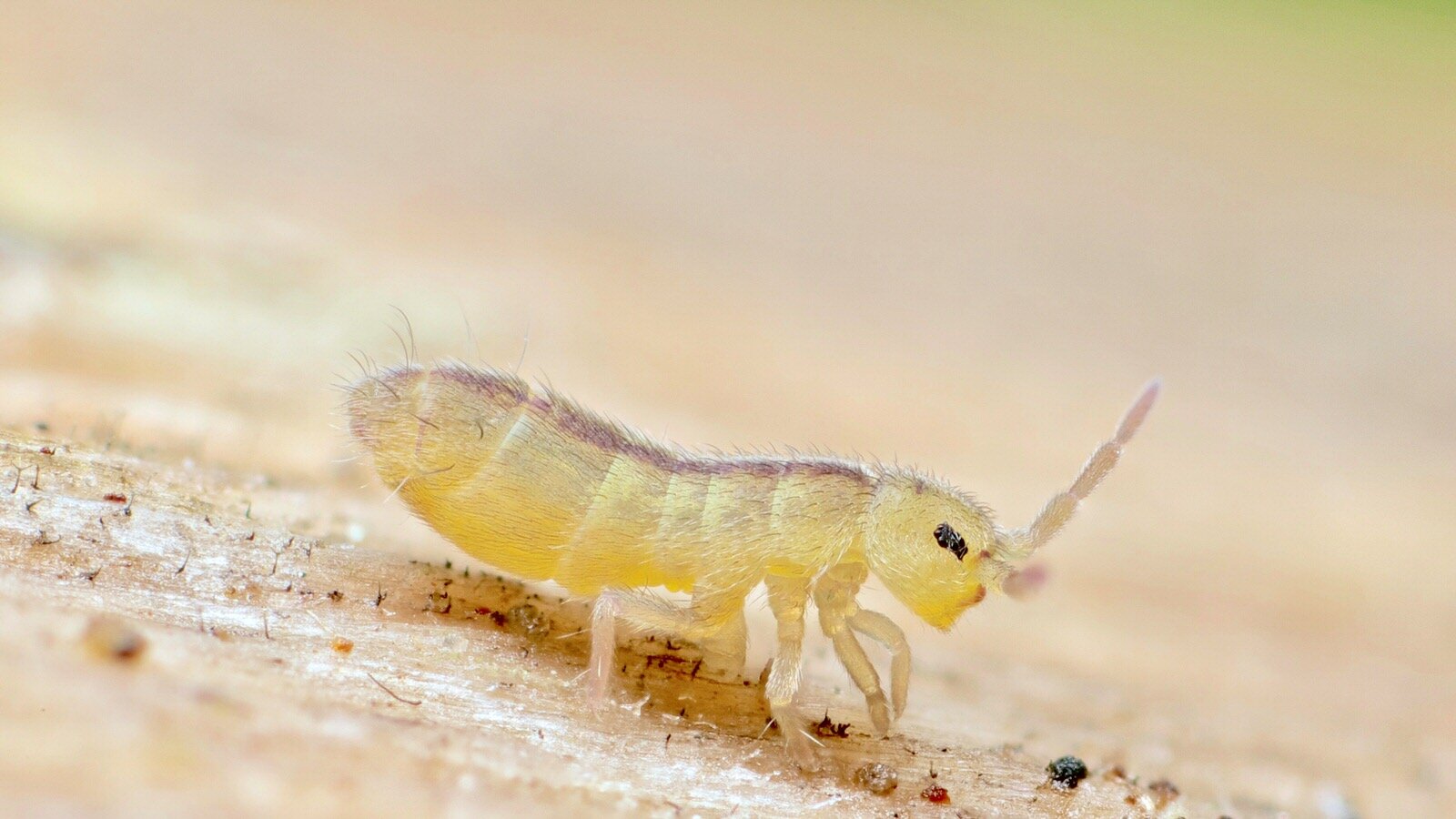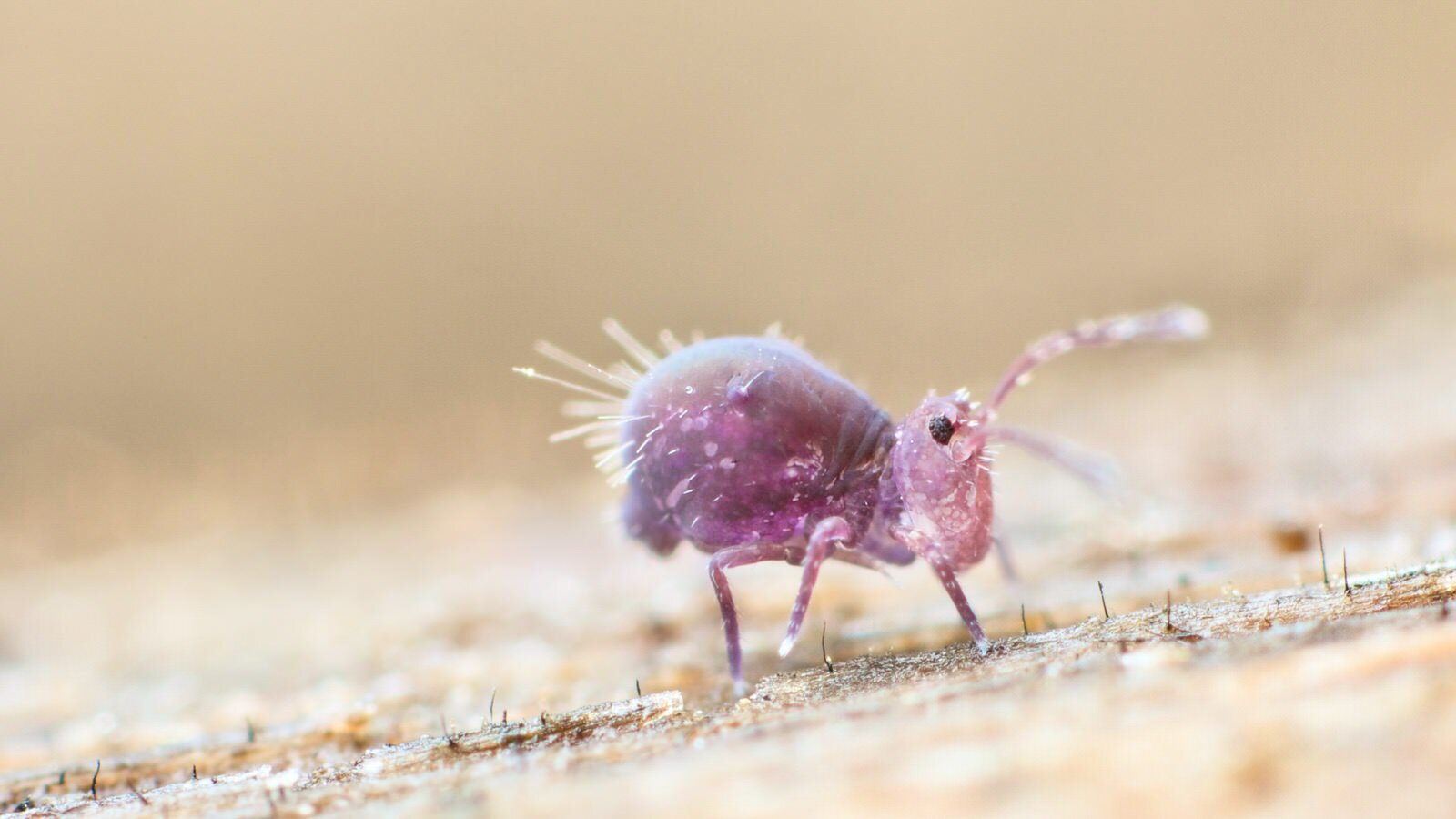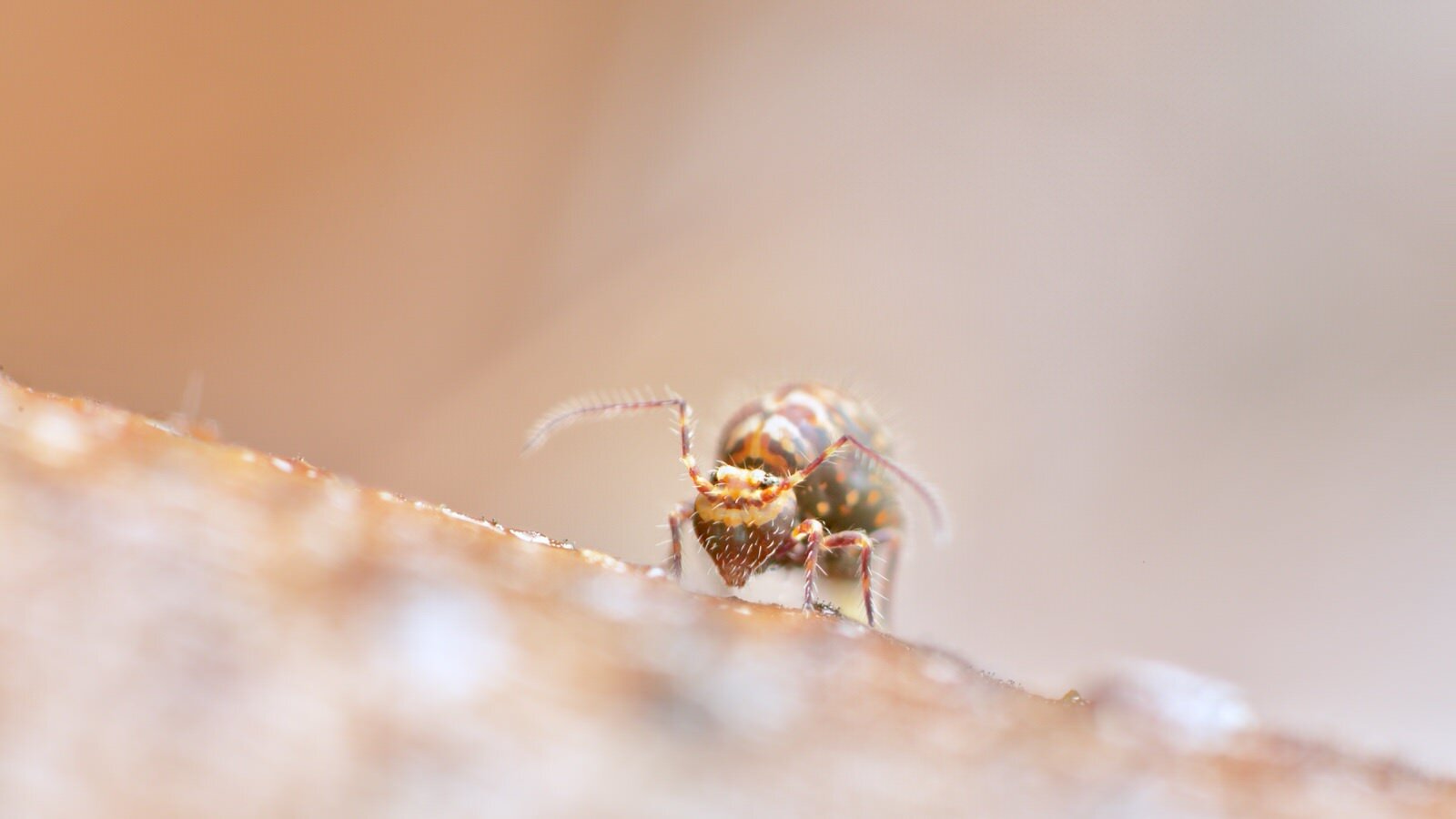
All about springtails (Collembola)-
a colourful life in the soil
Springtails (Collembola) are ancient, six legged and usually very small animals that live in and around soil, as well as up trees, on ponds, and most other places you can think of. They’re complex, unusual, often intensely colourful, incredibly endearing and very tiny and common members of mesofauna worldwide. Springtails aid with nutrient cycling in the soil, helping to form soil microstructure as well as being a ready supply of food for many predators. And they've held a very special place in my heart for the last nine years. For an animal very often under 1mm big, that's quite some achievement.
Sminthurides malmgreni, Compton Dundon, Somerset UK, February 2020
Springtails really are amazing. It’s no secret that they are my beloved favourite amongst the myriad of different soil mesofauna. Not surprisingly, they are also my favourite animals in the world.
You can check out some of my best images of springtails here
Sadly though, helped by the internet, many people now believe that springtails are bad. Nearly all pest control companies online are invested in mis-representing them as an unpleasant nuisance, describing snow fleas as ‘infestations’ or ‘plagues’- nasty, small, jumping insects or springtail bugs, needing to be removed wholesale from the house and garden.
This belief is also actively encouraged by a surprising amount of gardening websites who really should know better. Springtails are described as colourless little biting insects that need eradicating from the soil, along with mites and the other soil animals. Pictures of springtails are provided, usually mislabelled and more often than not, actually depicting aphids, beetle nymphs and mites.
Both the gardening and pest control company sites offer chemical solutions to this end, at special discounted website prices.
And then, if that wasn’t enough, there’s Morgellons, a condition where many believe that their skin is infested (that word again) with springtails.
It isn’t.
Apart from showing that you have a damp problem in your house, a healthy garden or a propensity to believe made up crap on the internet, springtails are actually benign and nearly always beneficial, as well as being exceedingly beautiful. And they’re not insects.
This is how it’s done- Check out The Laidback Gardener, a blog by Larry Hodgson, a Canadian writer and gardener. Obviously.
Temeritas species juvenile, Lamington National park, Queensland, Australia, Jan 2016
It's hard not to anthropomorphise Collembola, especially the Symphypleona, the globular springtails who as their name suggests, are rounded rather than elongated or flattened. They look cute and chubby, often with big, black eye patches and a tendency to turn their heads upwards, as if they were looking back.
The freshly hatched baby springtails have even bigger eyes for their size, with the big heads and smaller bodies of most babies across the world. They just want to be hugged. If only they wouldn't squash…
Allacma fusca, Somerset, UK
For extra info and an ID resource for springtails, check out Checklist of the Collembola of the World
Where do Collembola live? What are springtails?
Welcome to Collemboland
Cradle Mountain, Tasmania and billions of springtails.
Collembola are one of the most widely spread and numerous of all animals in the world. They live virtually everywhere. Car parks, compost heaps and city streets, in sand, up trees, on water, in houses, on plants. And in and around soil, of course. Wherever you go, looking with a hand-lens, there will most likely be a springtail scampering away from you.
They're officially the deepest living land animal, with a new species, Plutomurus ortobalaganensis, found in Krubera-Veronja cave in the Western Caucacus at a depth of 1,980 metres (6,500 feet) below ground. It was tempted out using cheese.
Desoria and Hypogastrura species of Collembola have been recorded happily living at 6,400 metres/21,000 feet on the high slopes of Mount Everest, while another genus in Tasmania lives for certainly part of its life, underwater, eating crunchy diatoms.
Collembola are one of nature's ultimate niche fillers, able to find a way into almost any environment in the world, given time. And time is something they've had a lot of. In 1919 a fossil collembolan, Rhyniella praecursor was found in the Rhynie chert. The chert dates to around 410 million years old, meaning that collembolans were one of the very first arthropods to become terrestrial.
It can be posited that the first Collembola-like animals ventured from the sea into a semi-aquatic environment on the shoreline as a littoral animal, before spreading onto land through the humic, moist, temperate forest soils surrounding the sea. Overall, springtails still prefer a high moisture content environment, having also evolved an incredible water repelling skin to deal with it. It works so well that it also repels dirt and even oil.
Collembola moult throughout their lives, up to fifty times, although they struggle to regenerate their antennae completely if damaged.
Once attaining maturity, they don’t keep growing, although some attributes like stronger colour or more pronounced features are noticeable in older specimens. Moulting has a marked similarity to that of a crustacean. They have a curious moulting strategy, cycling between an eating phase and a breeding phase with each moult. The mid gut is also regenerated with every moult as an excretory function, enabling the regular removal of mineral build up and toxins in the body.
Although until recently, they were grouped with insects, Collembola, along with Diplura and Protura are now thought to have followed some sort of parallel but not particularly linked evolution. But nothing is fixed. The fact is that things just don't fit comfortably into boxes, apart from cats. DNA bar-coding has certainly helped clarify some areas of confusion in the Insect/Entognatha situation while muddying many others.
They do share some attributes of insects, with a body divided into three parts, consisting of a head with antennae, a three-segmented thorax, each segment having a pair of jointed legs, and an abdomen. However, in most other regards, Collembola differ. They are all soft bodied, and lack wings. They also have internal mouthparts, as well as a furca and collaphore, unique structures to their order. Even their simple eyes, or ocelli, bear more resemblance to the eyes of crustaceans than insects.
Francesco Nardi et al published an influential paper in 'Science' in 2003, building on research from the USA and Japan. In it, they offered some of the first strong molecular and developmental evidence suggesting that the Entognatha, and in particular, Collembola, were closer to Pancrustacea than any base ancestor shared with Insecta. The six legs that Entognatha and insects once had in common are maybe less of a link than a coincidence. Especially as Diplura and Protura have both retained extra leg-like appendages, so really, only Collembola count...
Even more recent research, such as the 2013 paper by Sasaki et al, suggests a separate lineage for Protura, with a closer linkage between Diplura and Colembola to insects. It's damn tricky. Even the constructed class of Entognatha is questionable, with the three sharing very little in common, least of all, genetics.
Collembola’s glue piston- what’s in a name?
Sminthurus viridis stood on my wet, waterproof trousers, vesicles eversed into the water. East Pennard, Somerset, Sept 2015
The word ‘Collembola’ derives from two Greek words meaning glue and piston, named through observations of Collembola anchoring themselves to a surface using their collaphore, a tube-like structure containing two eversible tubes, under their abdomen. I've observed this action myself, but while it most certainly is used for stabilising in certain situations, its main use, through the eversion of the two vesicles, are thought to be the regulation of the body's water balance and excretion.
Brachystomella parvula Wetherby, W. Yorkshire December 2016
Novokatianna species juvenile with eversible tube, Thames, NZ March 2016
A short, modern Collembola history
The first person to properly study Collembola was Charles De Geer, a friend and contemporary of Carl von Linné/Carolus Linnaeus. He wrote his first ever article about Collembola in 1740 at the age of twenty, after being made a member of the Swedish Academy of Sciences. A century or so goes by, which I’ll completely gloss over, until we get to John Lubbock, the hero of the piece- a victorian intellectual, archaeologist and entomologist.
Lubbock, a near lifetime friend and next door neighbour contemporary of Charles Darwin, had an affection for Collembola not shared by his erstwhile colleague. In Darwin’s words- “The members of this order are lowly organised for their class. They are wingless, dull coloured, minute insects with ugly, almost misshapen heads and bodies.”
His unforgivable dismissal of Collembola aside, Darwin was instrumental in fostering Lubbock’s early understanding of the natural world, having first met him aged eight. He bought Lubbock his first microscope, encouraged, mentored and guided him into a lifelong passion for entomology, alongside his other interests in archaeology, banking, politics, humanitarian concerns and general polymathery. His public lectures on ants regularly attracted thousands of adoring fans.
Lubbock’s books remain highly readable, a hundred and fifty years later. The joy and fondness he has for his subjects is delightful to rediscover. It’s also fascinating to see Darwin’s ideas on natural selection applied and thoughtfully explored in the context of insects and their allies.
Lubbock coined the name ‘Collembola’ in the first essential monograph on UK Collembola- Monograph on the Collembola and Thysanura, published in 1873. Here, he pulled together all the knowledge and observations he could find that had been published up to that point, along with his own astute observations of both Collembola and the now deprecated term for bristletails and silverfish and proceeded to make tiny history.
Change is something that many Collembola are very good at. In a stressed environment, some are able to shrink their body size and change their shape rapidly as a coping strategy, within the space of one moult. Some springtails are able to change so profoundly that new species were initially constructed to describe them before this ability was understood. The females can change the amount and size of the eggs that she lays, too, guided by environmental factors.
For furca's sake. How springtails jump
Springtail, the common name, comes from the ability of many Collembola to spring away from trouble using an appendage called the furca, meaning ‘fork’, held under tension beneath the abdomen.
Dicyrtomina minuta, overturned, showing the furca. Each end of the forked ‘spring’ tail has a paddle-like mucro that connects to the surface when jumping.
“…if a fallen bough be examined, a heap of moss be shaken over a pocket-handkerchief, or any long herbage swept with a hand-net, the naturalist will not fail to find… certain delicate, hexapod, active little creatures; the majority of which will endeavour to escape not only running with agility, but also springing with considerable force, by means of a sub-abdominal, forked organ, which, commencing near the posterior part of the body, reaches forwards, in most cases, almost as far as the thorax.” Lubbock, 1873
Pseudachorutes species, Stewart Island, NZ July 2014
Having the ability to jump away from predators is enormously energy-intensive to physically perform and for evolution to have maintained. However, as the main and often only form of defence for Collembola, it has proved to be highly effective, remaining hugely advantageous for such a vulnerable, soft and tiny animal. But over hundreds of millions of years, some found other ways to protect themselves and moved away from an ability to spring.
This loss can be traced to some combination of factors- the removal of a need to escape from predators, size and the confinement of limited space.
Many of the larger species in the Poduromorpha spend much of their lives buried deep within massive, fallen and rotting trees in forests, away from from the prying chelicerae of mites and pseudoscorpions. The relative safety and confined living conditions afforded by a log removes the need to retain such an energy- intensive ability like jumping.
In such a safe, hidden home, there would be an opportunity instead to grow in size, flatten, to easier fit within cracks, or develop spikes, lobes and digitations as a visual defence. Their size alone would also prohibit a workable furca, but probably, their lifestyle niche filling drove the changes and an increase in size was a secondary advantage.
Increasing size may have conferred protection from Collembola’s traditional predators, but occasionally venturing outside in pursuit of slime moulds means exchanging attacks by mites for avian predators, now being big enough to be seen by birds. It’s interesting to note that every large Poduromorpha collembolan I’ve observed is also incredibly fast for its size. Many of the Poduromorpha also have a chemical defence, having a nasty tasting substance they can exude when under threat or attacked. Dr Palacias-Vargas, a Mexican collembologist, has confirmed that they really do taste absolutely awful.
Platanurida species, running sideways into a crack. Stewart Island, NZ June 2014
Not only the largest Collembola have lost their furcas. Most of the deeper soil-dwelling Collembola, like the Onychiuridae and Tullbergiidae, have also lost the ability to jump. However, the members of Neelidae do still have a functioning furca, even though they live in the bottom layers of leaf litter and top layers of soil. Certainly for the tiny Megalothorax species, having the ability to jump away in a very cramped environment is still potentially possible and therefore has some worth.

In the case of species like this Odontellidae, their furca is much reduced, although can still be pressed into action when needed. Unfortunately, when startled, or under attack, the chubby springtails are now only able to fall over, presumably distracting would-be predators with comedy.
Just after attempting to spring. Odontella species, Greymouth, NZ May 2014
Cave life and springtails
Living in the dark of caves, or deep in the soil layers inevitably leads to a whole set of adaptions for Collembola. Pigments get discarded, antennae change length and the amount of tiny ocelli on the eyepatches may reduce in number over time or disappear entirely.
And they slow down. Cave Collembola usually subsist on very little. They can't afford to waste energy running around so they often slow down. In an energy-poor environment, each small saving made to their energy usage aids survival.
Arrhopalites pygmaeus wandering in the darkness. Goatchurch Cavern, Somerset, Oct 2013
Arrhopalites species, Annapolis County, Nova Scotia, Canada, June 2015
Neelus murinus, Launceston, Tasmania, Australia, March 2014
Adelphoderia species, Westbury, Tasmania, Australia September 2014
Sminthurides aquaticus eggs on pondweed, almost ready to hatch.
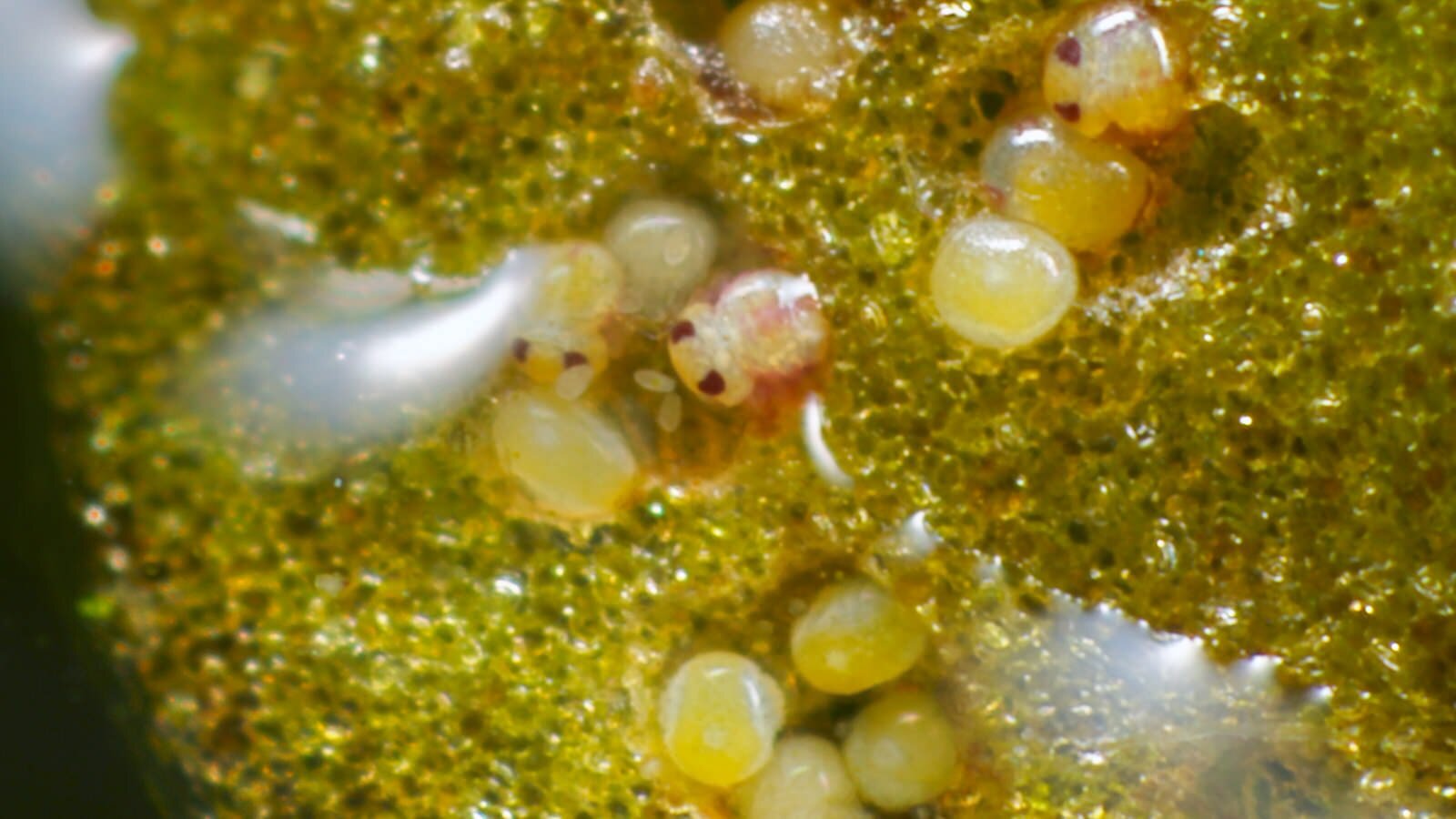
Collembola Orders
Collembola can be split into three, or, more controversially, four orders. The Entomobryomorpha, Poduromorpha, Symphypleona and that controversial one, Neelipleona. At the risk of disagreement, and because I really love the Neelidae, I'm going to keep to the four groupings, to give them the status that they so obviously deserve....


